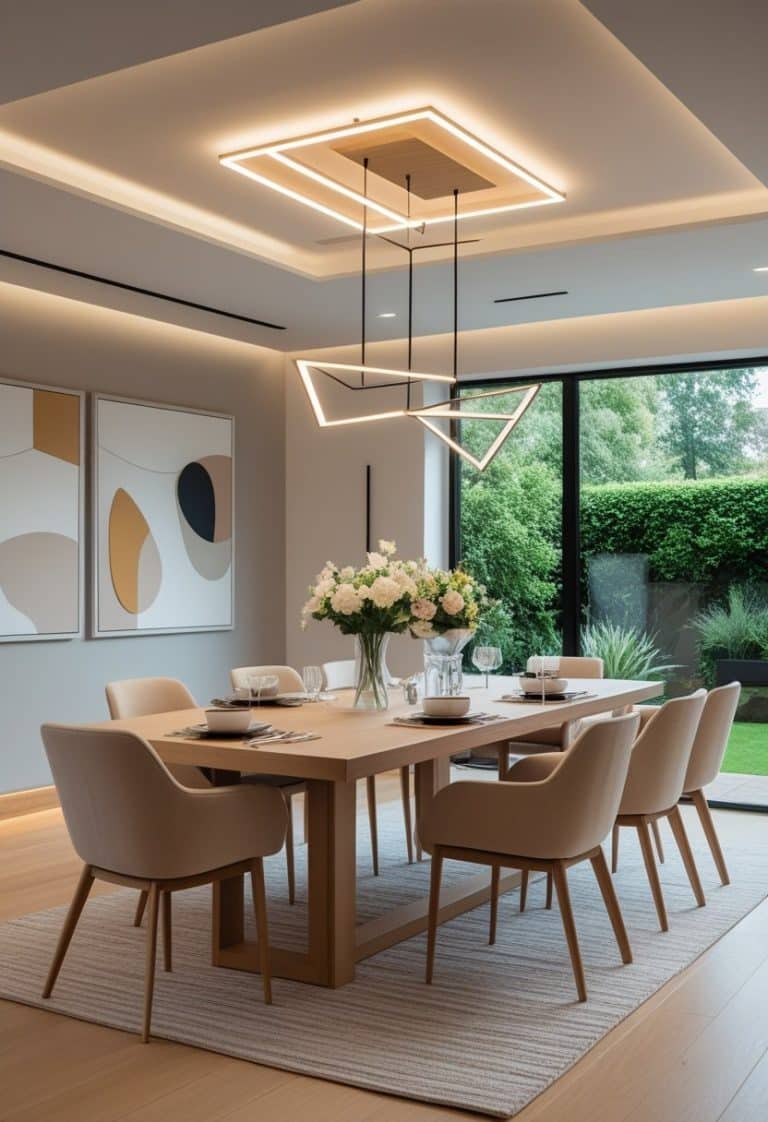21 Warm-Toned Dining Room Interiors That Blend Comfort and Style

Warm tones bring a sense of comfort and ease to dining spaces, making them feel more welcoming and lived-in. By using colors and textures that echo natural warmth, a dining room can shift from a simple eating area to a space that encourages connection and relaxation. A warm-toned interior helps create an inviting atmosphere that balances style with comfort.

This article explores how different design elements—such as wall colors, lighting, furniture, and decor—work together to shape a cohesive and inviting dining space. From subtle accents to bold choices, each idea highlights practical ways to introduce warmth while keeping the design timeless and functional.
1) Terracotta Walls for Earthy Warmth

Terracotta walls bring a grounded, natural feel to dining rooms. The warm clay tone pairs well with wood furniture and soft lighting.
This color works in both modern and traditional spaces. It adds depth without overwhelming the room, creating a calm and welcoming setting for meals.
2) Amber Accent Lighting

Amber accent lighting adds a soft, warm glow that makes dining spaces feel inviting.
Pendants, chandeliers, or sconces with amber glass can highlight the table and create a balanced atmosphere.
Using amber bulbs or shades helps reduce harsh brightness while keeping the room comfortable for gatherings.
3) Caramel Upholstered Chairs

Caramel upholstered chairs bring a warm, natural tone to dining spaces. Their soft leather or fabric finishes pair well with wood tables and neutral walls.
Many designs feature simple lines with solid wood legs, making them versatile for both modern and traditional interiors.
The caramel shade adds subtle contrast without overwhelming the room’s overall palette.
4) Rustic Wooden Dining Tables

Rustic wooden dining tables bring warmth through natural textures and visible grain. Their sturdy design often makes them the focal point of the room.
Many feature reclaimed wood, which adds character with small imperfections. These details create a casual, inviting space suited for everyday meals or gatherings.
5) Velvet Cushions in Mustard Yellow

Mustard yellow velvet cushions add warmth and depth to a dining room. Their rich tone pairs well with earthy colors like olive or terracotta.
They also work with darker shades such as charcoal or black for a modern look. The soft velvet texture brings comfort and subtle elegance.
6) Natural Wicker Chairs

Natural wicker chairs bring texture and warmth to a dining room. Their woven design adds visual interest without overwhelming the space.
Made from rattan or similar fibers, these chairs pair well with wood tables and light walls. They fit into both casual and traditional interiors.
7) Brass Light Fixtures

Brass light fixtures add a warm tone that works well in dining rooms. Their golden finish reflects light softly, creating a balanced atmosphere.
They come in many forms, including chandeliers, pendants, and sconces. Each option can suit different room sizes and layouts while maintaining a consistent style.
8) Peach-Toned Wall Art

Peach-toned wall art adds a soft warmth to dining spaces without overwhelming the room. It works well with both light and dark furniture.
They can choose framed prints, canvas pieces, or simple illustrations to highlight the color. Subtle designs keep the focus on the inviting tone.
9) Taupe Ceramic Dinnerware

Taupe ceramic dinnerware adds a soft, neutral tone that works well with warm dining spaces. Its balance of gray and brown creates a calm backdrop for meals.
The simple finish pairs easily with wood tables, metal accents, or linen textiles. This makes it a versatile choice for everyday use or gatherings.
10) Warm Oak Flooring

Warm oak flooring gives the dining room a natural and inviting base. Its medium tone works well with both light and dark furniture.
The grain patterns in oak add subtle texture without overwhelming the space. This makes it a versatile choice for many interior styles.
Oak floors also pair easily with warm wall colors like beige, cream, or terracotta. This creates a cohesive and balanced look.
11) Burnt Sienna Area Rugs

A burnt sienna rug adds warmth to a dining room with its earthy, reddish-brown tones. It works well on hardwood or tile floors.
This color pairs easily with wood tables and neutral chairs, creating a balanced and inviting setting.
Handmade or patterned designs can introduce subtle texture without overwhelming the space.
12) Soft Linen Tablecloths in Warm Beige

A beige linen tablecloth adds subtle warmth to a dining room. Its neutral tone pairs well with wood furniture and soft lighting.
The natural texture of linen creates a relaxed yet refined look. It works for both casual family meals and more formal gatherings.
Layering with simple dinnerware or muted textiles helps maintain a cohesive, warm-toned setting.
13) Deep Forest Green Accents

Deep forest green adds depth and richness to a dining room. It works well with warm wood tones and natural textures.
They can use this shade on walls, chairs, or curtains to create a grounded atmosphere. Subtle lighting helps balance the darker color.
14) Candlelit Centerpieces

Candlelit centerpieces add soft light that makes a dining room feel calm and inviting. They work well with both modern and traditional interiors.
Simple glass holders, brass candlesticks, or grouped votives can create a warm focal point. Pairing candles with greenery or seasonal flowers adds texture and balance.
15) Warm Minimalist Shelving

Open shelving in a dining room highlights simple ceramics, wood bowls, or glassware.
Natural materials and neutral tones keep the look calm and uncluttered.
Soft lighting can draw attention to textures while maintaining a clean, balanced style.
16) Copper Pendant Lamps

Copper pendant lamps bring a warm glow that works well in dining spaces. Their metallic finish reflects light softly, adding depth without feeling harsh.
They pair easily with wood tables or neutral walls, creating balance between modern and rustic design. Many homeowners use them to highlight the dining area.
17) Textured Terracotta Planters

Textured terracotta planters bring natural warmth into a dining room. Their earthy color pairs well with wood furniture and muted tones.
They work as simple accents on sideboards, window sills, or in corners. The rough surface adds depth without overwhelming the space.
Paired with greenery, these planters create a balanced, organic look.
18) Rust-Colored Drapes

Rust-colored drapes add warmth and depth to a dining room. Their earthy tone creates a cozy setting that works well for gatherings.
They pair easily with neutral walls or natural wood furniture. This makes them a versatile choice for both modern and traditional interiors.
19) Amber Glassware Sets

Amber glassware sets bring a warm, golden tone to the dining table. Their soft color works well with both neutral and bold table settings.
They are available in many styles, from simple everyday pieces to handmade designs. Sets often include drinking glasses, bowls, or plates.
The warm tint adds subtle character without overwhelming the overall look of the dining room.
20) Caramel Leather Dining Benches

Caramel leather dining benches add warmth and texture to a dining room. Their rich tone pairs well with wood tables and neutral walls.
They provide flexible seating, making them useful for both daily meals and larger gatherings.
The leather surface is durable, while the caramel color creates a soft, inviting look.
21) Warm White Trim Detailing

Warm white trim creates a clean frame that softens bold wall colors without feeling stark. It works well in dining rooms with both light and dark palettes.
Designers often choose shades like Cloud White or White Dove because they balance warmth with brightness. This detailing adds subtle contrast and keeps the space inviting.
Key Elements of Warm-Toned Dining Room Design

A warm-toned dining room relies on thoughtful use of color, natural materials, and lighting. Each choice works together to create a space that feels comfortable, balanced, and inviting without losing function or style.
Color Palette Selection
Warm dining rooms often use shades like terracotta, caramel, amber, and mustard yellow. These tones create a grounded atmosphere and pair well with both rustic and modern furniture. Softer options, such as peach or buttery yellow, can brighten smaller rooms without overwhelming them.
Layering colors adds depth. For example, a terracotta wall can be balanced with neutral trim or lighter upholstery. Accent colors like olive green or deep plum work well in artwork, table linens, or chair cushions.
When selecting paint or finishes, testing samples in natural and artificial light is important. Warm tones can shift in appearance depending on the time of day. A matte or eggshell finish often looks softer than a glossy surface, making the room feel more relaxed.
Material and Texture Choices
Natural materials strengthen the warmth of the color scheme. Wood tables, woven chairs, and stone accents bring texture and durability. Reclaimed or lightly distressed wood adds character, while smooth finishes create a cleaner look.
Layering textures makes the space more inviting. A wood table with linen runners, ceramic dishes, and a jute rug creates a balanced mix of surfaces. Upholstered seating in velvet or leather can add comfort and contrast.
Small details also matter. Wicker baskets for storage, clay vases, or metal light fixtures in bronze or brass tones reinforce the warm aesthetic. Using a variety of finishes prevents the room from feeling flat or one-dimensional.
Lighting for Warmth
Lighting plays a central role in shaping mood. Warm-toned bulbs with a color temperature around 2700K–3000K create a soft, inviting glow. Pendant lights or chandeliers above the table provide focus, while wall sconces or floor lamps add layers of illumination.
Dimmers allow flexibility, making the space suitable for both casual meals and formal gatherings. Candlelight can also enhance warmth, especially when paired with reflective surfaces like brass or glass.
Natural light should not be overlooked. Sheer curtains let sunlight filter through without harsh glare, softening the room during the day. Positioning mirrors near windows can help distribute light evenly across the space.
Styling Tips for Cohesive Warm-Toned Spaces

Warm dining rooms feel most inviting when every detail works together. The right mix of accents and natural materials helps create balance, depth, and a sense of flow without overwhelming the space.
Balancing Accessories and Decor
Accessories should highlight the warm palette without competing for attention. Small changes, like swapping silver hardware for brushed brass or copper finishes, can shift the mood toward warmth. Lighting also plays a role—lampshades with soft linen or amber glass add a subtle glow that enhances earthy tones.
Textiles are another way to layer warmth. A wool or cotton table runner, paired with linen napkins in muted reds or browns, adds texture without clutter. Rugs in terracotta or rust shades ground the room and connect the dining table to the rest of the décor.
To avoid monotony, contrast warm tones with a few cooler accents. For example, a deep walnut table pairs well with neutral gray seat cushions or a pale stone centerpiece. This balance keeps the room from feeling heavy while still emphasizing warmth.
Integrating Natural Elements
Natural materials work well with warm tones because they carry their own richness. Wood finishes like oak, walnut, or cherry bring depth, while woven textures such as seagrass or rattan add dimension. These materials also age gracefully, keeping the space timeless.
Plants help soften structured dining spaces. A potted olive tree or simple greenery in a clay vase introduces organic shapes and muted greens that complement warm palettes.
Stone and ceramics also add balance. A travertine serving tray or handmade pottery centerpiece provides texture and ties together wood, fabric, and metal elements. Using these pieces sparingly ensures the room feels layered but not crowded.


